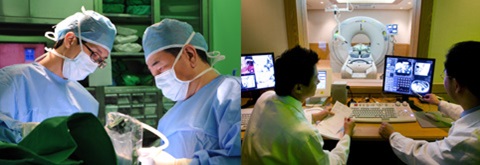
Approximately 60~70% of stroke is due to cerebral infarction, which involves the condition when the brain cannot get enough blood flow due to clogged cerebral vessels. As the blood carries necessary nutrients and oxygen to the brain cells, cerebral ischemia permanently damages brain cells near vascular legions. Cerebral infarction is classified as thrombotic cerebral infarction, embolic infarction, hemodynamic ischemic stroke, or lacunar infarction depending on the cause of the disease, however, it displays common symptom of neurological abnormalities due to brain cell damages regardless its classification.
Recent development in medications and surgical technique as well as continuous education about the disease has helped improving the result of cerebral infarction treatment. Prompt diagnosis and treatment is crucial for cerebral infarction as the disease itself damages nerve. Method of treatment for each individual is unique as his/her type, location, size of infarction, and the time of hospital admission from the onset of the symptom is different.
For acute cerebral infarction, the injection of thrombolytics into the vein can unclog the problem area if the patient is admitted to the hospital within 3 hours of the onset of symptoms. For most of patients who didn’t make it to the hospital within 3 hours, hospitalization is necessary to undergo the treatment with anticoagulant, antithrombotic, or antiplatelet agent. In addition, rehabilitation therapy along with the medication can maximize the therapeutic effect.
As for the surgical method, artery endothelial removal is performed to get rid of thrombus or embolus inside the internal carotid artery or cerebral artery. Bypass surgery grafts branches of external carotid artery, peripheral artery or vessel to vascularize clogged area. If there is any chance of brain hernia because of the intracranial pressure and the area of infarction being too high or wide, emergency decompressive craniectomy may be performed. Recently, the method of dissolving blood clots by administering thrombolytics through the catheter or removing thrombus or embolus by inserting device directly into the vessels along with angiography is used for better result.